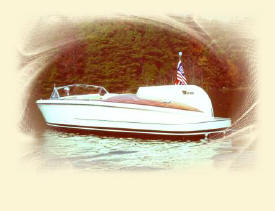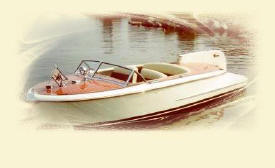
A Memory, A Reality
by Jim Aamodt.
The year 2002 will mark the 100th Anniversary of Ventnor Boats. Adolph E. Apel first established his company in Ventnor, New Jersey. His vision was to build boats that would successfully adapt the gasoline engine as the predominant source of lightweight, efficient, and fast power.
 As in early automobiles, gasoline engines had to be proven to the public to have virtues of speed, endurance, and reliability. Adolph was an excellent mechanical engineer, and chose his commercially built power well. His ability to adopt new hull designs of lightweight yet durable construction was proven in his successful involvement with inboard racing. Ventnor boats continuously updated their designs, as lighter and greater horsepower engines became available. A 1913 example was Tech Jr., built for
As in early automobiles, gasoline engines had to be proven to the public to have virtues of speed, endurance, and reliability. Adolph was an excellent mechanical engineer, and chose his commercially built power well. His ability to adopt new hull designs of lightweight yet durable construction was proven in his successful involvement with inboard racing. Ventnor boats continuously updated their designs, as lighter and greater horsepower engines became available. A 1913 example was Tech Jr., built for
T. Coleman Dupont which was the worlds first recorded boat to exceed the over a mile-a-minute (60.3 MPH) mark.
The Ventnor Company built a wide variety of custom launches, tenders, utilities, runabouts, and commercial small craft into the 1930s. Their racing involvement remained strong, and the 1931 American Power Boat Associations (APBA) creation of a 135 cubic inch displacement racing class was immediately dominated by Ventnor. The Flying Eagle set the 1931 speed record of 35.7 MPH, and in the succeeding years of the 1930s, the 135 class records were held by Ventnor at 54.08 MPH lap speed, and 67.5 MPH flying mile.
In 1934, the APBA introduced the 225 class, and Ventnor set a record of 44.14 MPH. Later in the 1930s, Ventnor set the record at 66.4 MPH lap speed, 87.5 MPH flying mile. Ventnor boats, privately owned and raced, held virtually all records in the 91, 135 and 225 cu. in. classes, as well as many divisional and national championships.
 Adolph Apel invented the five-point suspension hull in 1935, and refined it to the three-point style. He patented the three-point suspension hull in 1936 in the US and UK, and it is still used today. This design was a major development in both water resistance and stability. During this time, Adolphs son, Arno, became president of the company and continued with the same visions. The company continued a wide line of pleasure boats, with racing boats still being the dominant focus. Some of their 1930s fast boats were Miss Peps V, Tempo VI, My Sin, So Long, Lady Glen IV, Hi Ho II, Eagle and many others.
Adolph Apel invented the five-point suspension hull in 1935, and refined it to the three-point style. He patented the three-point suspension hull in 1936 in the US and UK, and it is still used today. This design was a major development in both water resistance and stability. During this time, Adolphs son, Arno, became president of the company and continued with the same visions. The company continued a wide line of pleasure boats, with racing boats still being the dominant focus. Some of their 1930s fast boats were Miss Peps V, Tempo VI, My Sin, So Long, Lady Glen IV, Hi Ho II, Eagle and many others.
Their racing notoriety was recognized in 1937 with an order of 12, 20 boats by the Chinese government. For use as Suicide Boats, they were powered by a Lycoming Engine, and designed to run at 64 MPH with a 500-pound bomb in the bow! Their intended use was in the on-going Sino-Japanese War. For political reasons, only 11 were delivered, and the 12th hull remained at the Ventnor factory.
Jack Rutherford purchased hull #12 and replaced the power plant with a Packard 621 cu. in. Gold Cup engine. In 1937, at the Presidents Cup Race, it ran at 72.7 MPH, 1 MPH faster than the three-time Gold Cup winner, El Lagarto. This boat, named Juno, is still participating in boat shows and Race Boat Regattas.
Ventnor designed other fast boats. In 1938, Ventnor designed the hull for Malcolm Campbells Bluebird, which was clocked at 141.74 MPH in England. Likewise, Ventnor also designed, built and won the Gold Cup with My Sin, in 1939.
Ventnor built pleasure boats and custom race boats through 1939. With the advent of the war, Ventnor moved to Atlantic City, New Jersey, and built military vessels 23 through 110.
At the end of the war, the Apels added several experienced pleasure boat production people. They decided to focus on this wider base market. Their first new model in 1947 was an 18 deluxe utility runabout. Sales were good and their racing knowledge helped produce a fast pleasure boat reaching 44 MPH.
The first year of a complete line was 1946. They offered models from 156 through 229. The 156 was built of plywood, as were the boats extensively used during WWII. Planked boats were offered starting in a 16 length, and considered to be standard construction through the 229 Custom Runabout style. Gray Marine engines were predominant, with the 229 having twin 150s for 55 MPH performance. In 1947, one cruiser, a 23 Express, had options up to twin Gray 150s.
Most notable, beginning in 1945 (and about 9 years before the automobile industry styling) was the 20 Sport Runabout and the 23 Sport Runabout (229) introducing the torpedo-style rear and sloping dorsal fin. As a major styling innovation, the fin models combined an oak frame, mahogany-varnished decks, and painted sides
consisting of both planking and cold molded plywood. A few 19, 20 and 23 Sport Runabout models were built with all varnished sides and two-tone decks.
In 1945, the 20 model could also be ordered with a (then well-advertised) Tucker Engine. This was highly
possible, as the Tucker was a Lycoming, and Ventnor had previously used many Lycoming marine engines.
Like the finned 1955 Chris Craft Cobra, the 1945 finned Ventnor looked great as a contemporary design, but did not sell well to some because of the Art Deco design. However, it did define a unique model that has become a classic. The finned Ventnor was not renewed in the 1951 models.
Competition was fierce for the consumer spending boom, and Chris Craft, Century and Higgins, were masters at mass producing low cost, good quality boats. Others such as Hackercraft, Owens, Lyman, Correct Craft, Garwood, Larson etc. were competitors after the same market.
After moving to Egg Harbor, New Jersey, Ventnor continued to build 20 to 40 lapstrake and plywood cruisers until 1968. The company then faded away in the mass transition to fiberglass boats after their merger with Cruisalong Co.
Quality, as well as innovative design, was always an important factor for Ventnor. Their innovative design of the torpedo transom, however, exceeded the ability of plywood. In the late 40s, although the best choice of the time, plywood was not competitve with the new fiberglass. It is ironic that the new material, fiberglass, which later Ventnor would not adapt to, could have enabled their designs to be built better, cheaper, and much more durable.
 The Art Deco look of the late 30s, through the late 40s is captured in the Ventnors finned Sport Runabouts. In 1994, Dick Thede of Harrison, Tennessee, culminated his several years of research on Ventnor boats by reincarnating the Ventnor Company, and its 1940s era 20 Sport Runabout design. Today, Dicks revived Ventnor Boat Works
The Art Deco look of the late 30s, through the late 40s is captured in the Ventnors finned Sport Runabouts. In 1994, Dick Thede of Harrison, Tennessee, culminated his several years of research on Ventnor boats by reincarnating the Ventnor Company, and its 1940s era 20 Sport Runabout design. Today, Dicks revived Ventnor Boat Works
produces the 20 Ventnor on a custom-built basis, with color, power, hardware, and many other items specified uniquely for each boat. Current Ventnor boats are built with the materials which best fulfill the 1940s design, but with 21st Century technology, durability, and high quality standards. I have seen two of his boats and both the quality of construction and faithfulness of design are excellent. The ambiance of the original has been retained and if Arno or Adolph Apel were around, I think they would not only approve, but also wish they had available epoxy, lightweight 250-300 HP engines, current molding techniques, high UV resistant leather etc. for their era.
A 100 years of Ventnor Boats will be featured at the Mt. Dora Boat Show, as well as others next year. I have only touched the historical surface, so why not have some research fun and seek out some Ventnors at boat shows. We are very pleased to have Dick Thede at our Rendezvous with a current 20 Ventnor. Be sure to see him (and his boat.)
Dick, thanks for making memories come alive!

